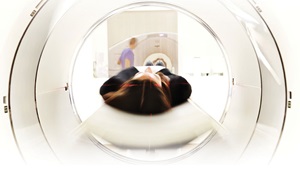Direct-to-Consumer Imaging Centers Offer Whole Body Imaging With Little Context
Patients often left struggling to interpret results or to seek a second opinion


For many people, the allure of addressing health issues before they are beyond medical treatment, can provide peace of mind. Marketing efforts used by whole-body imaging services tend to highlight “lifesaving diagnoses.” Unfortunately, such claims can be more hype than substance.
Many companies offer whole-body MRI scans that they say can screen for more than 500 conditions in 60 minutes or less. The price tag for the service is around $2,500.
“What's often advertised with whole body screening is that it will detect a treatable cancer that would otherwise have gone unchecked and killed you,” said Christopher Hess, MD, PhD, the Alexander R. Margulis Distinguished Professor and Chair of the Department of Radiology and Biomedical Imaging at the University of California, San Francisco. “But the actual number of cancers that act that way is very small.”
Linda C. Chu, MD, agrees.
“The idea of screening exams, such as mammography or lung cancer screening with CT, is to detect pathology early, with improved patient outcomes due to early intervention. These types of screening exams often target patients at higher risk of disease, such as long-time smokers, in order to improve the yield of the screening test while minimizing false positives and reducing costs,” said Dr. Chu, associate professor of radiology and associate director of the diagnostic division at Johns Hopkins University, Baltimore. “The yield of these whole-body MRIs in a non-targeted population will be low and the false positives and incidentalomas will lead to increased utilization.”

Quality Rollback
Dr. Hess questioned a whole-body MRI’s ability to detect the oft-advertised “rare but aggressive cancer.”
“Definitively excluding pancreatic cancer requires a very high-quality abdominal MRI—at a level of quality that whole-body techniques cannot match,” he said.
In addition, Dr. Chu noted that whole-body screening MRI sequences are not optimized to characterize the pathology in each body part and may lead to more follow-ups.
“To my knowledge, these screening MRIs are not optimized to evaluate for coronary artery disease, which is another significant limitation because this disease remains the leading cause of death in the U.S.,” she said.
According to Dr. Hess, this difference in quality is the result of such services being driven by undue prioritization of profit. For medical imaging, one of the easiest ways to cut costs is to use a cheaper scanner and a fast, generic imaging protocol. As any radiologist knows, cheaper scanners tend to produce lower quality images.
“At the end of the day, you get what you pay for, though the patients who are paying $2500 for their scans may not understand that” Dr. Hess added.
Patient Driven Follow-Up Can Be Confusing
Consumer-driven imaging tends to be highly transaction-based. The patient undergoes a scan and gets a report. That’s it.
“The additional imaging, the biopsies, the advice, the worry and everything that usually happens downstream after a suspected abnormality is detected isn’t managed by the people who made the discovery,” Dr. Hess said.
It’s up to the patient to figure out what to do next, which can result in a disconnected and fragmented patient journey.
To illustrate, Dr. Hess recalled a frantic phone call he received one night from a person who underwent a whole-body MRI and was told that they had a brain aneurysm.
Understandably, this person was terrified and left wondering what to do. Not knowing anything about the imaging service and judging the poor image quality, Dr. Hess did what any radiologist would—he recommended repeating the imaging, but this time using a higher-quality scanner.
When the exam was repeated, it turned out there was no aneurysm.
Setting aside the needless stress caused and expenses incurred, this example highlights the impact that whole-body imaging can have on the radiology workstream.
“Companies began offering whole body low dose screening CT years ago, and it detected many incidentalomas that were incompletely characterized and required additional follow-up,” Dr. Chu said. “I anticipate the problem with MRI will be even greater, since MRI has higher contrast resolution than CT, so it is likely to detect smaller incidentalomas than CT, especially thyroid nodules, liver lesions and renal lesions.”
These incidentalomas will further increase the workload of radiologists and technologists who are already struggling to keep up with increasing demands, according to Dr. Chu.
“These additional exams may increase the waiting time for imaging and delay care for patients who legitimately need imaging,” she said.
The same challenges of false positives, incidental findings, additional tests and procedures, and unnecessary anxiety for patients may sometimes also be true with well-established screening programs in radiology, but at the least, these programs are evidence-based, rigorously vetted, and targeted to benefit population health.
“Currently, there is no evidence that whole-body MRI screening will improve health outcomes. Using the whole-body screening CT as an example, patients have felt compelled or influenced to get it when it was popular. Our experience showed that it was not beneficial or cost effective in most patients. The cost for whole body MRI screening is in the order of thousands of dollars and is usually not covered by insurance. This money is better spent on scientifically proven, evidence-based age-appropriate screening or health maintenance strategies.”
LINDA C. CHU, MD
Appropriate Use is Critical to Quality Care
Whole-body MRI screenings are part of a growing trend where imaging is based, not on the clinical needs of the patient, but on a patient’s willingness to pay—a trend that could chip away at medical imaging’s position as an essential cornerstone of quality medical care.
“Imaging is an incredibly powerful tool when it is done at the right place at the right time for the right patient and using the right modality,” Dr. Hess concluded.
It’s also important to consider the patient’s safety when using MRI.
“MRI safety is a major concern. Many patients have implantable devices, such as stents, shunts, pacemakers, defibrillators or bullet fragments, that may or may not be MRI compatible. Tattoos and piercings can also cause problems,” Dr. Chu said. “At hospitals and clinics, the technologists have strict protocols in ensuring that patients can safely undergo the exam. It is unclear whether these facilities will have similarly strict protocols and if radiologists will be immediately available to address any issues.”
For patients who have no indications for whole-body MRI, but who may be persuaded to seek this type of imaging, it’s important for them to talk with their physician or a radiologist, Dr. Chu said.
“Currently, there is no evidence that whole-body MRI screening will improve health outcomes. Using the whole-body screening CT as an example, patients have felt compelled or influenced to get it when it was popular. Our experience showed that it was not beneficial or cost effective in most patients,” Dr. Chu explained. “The cost for whole body MRI screening is in the order of thousands of dollars and is usually not covered by insurance. This money is better spent on scientifically proven, evidence-based age-appropriate screening or health maintenance strategies.”
For More Information
Access RSNA’s position statement on Appropriate Utilization of Medical Imaging at RSNA.org/Media.
Read previous RSNA News stories on MRI:
- Radiologists Address the Most Common Safety Issues for MRI
- Deep Learning Helps Speed MRI of the Spine
- Zero Echo-Time MRI Shows Diagnostic Efficacy Similar to CT